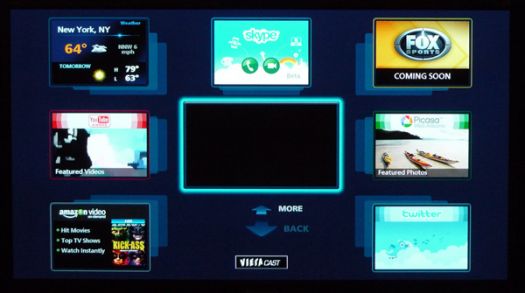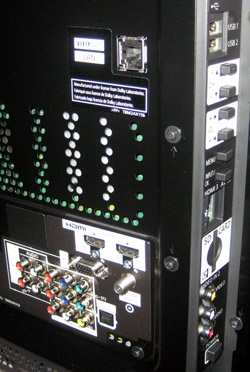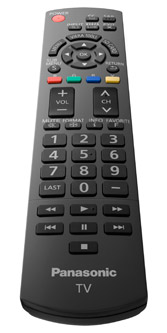Ah, sweet, sweet plasma. Its reputation for unmatched black levels precedes it, an essential factor to a proper movie-viewing experience in the home. Amid a dramatic shift toward LCD (and LED/LCD) in recent years, Panasonic continues to fight the good fight with a variety of new plasma models to suit a range of needs. Bringing a hard-to-resist combination of value and features, the VIERA G25 Series Plasma is certainly worth a look, particularly the sweet-spot 50-incher, the TC-P50G25.
The TC-P50G25 is a THX-Certified Display, having successfully passed a battery of critical performance tests, such as consistent brightness across the entire screen (uniformity) - a feat that has always been problematic for LCD and LED TVs. Acceptable black levels must also be assured, and to that end, the TC-P50G25 employs Panasonic's new Infinite Black Panel. This panel benefits from upgrades to the cell discharge area, for greatly improved contrast particularly when the TV is in a brightly-lit room, blocking ambient light and minimizing reflections. Black gradation meanwhile has been improved by reducing the electrical pre-discharge which leads to undesirable on-screen graying.
LCD has been blowing its horn about its enhanced refresh rates (the number of times the image is rendered on screen, vital to crisp fast-motion reproduction), in impressively large multiples of 120Hz. To counter this spec, Panasonic tenders their own "600Hz Sub-field Drive," which requires a bit of explanation. The screen's actual refresh rate for a full frame is 60Hz, but it does not refresh the entire screen at one time. Instead it builds the image up from nothing to the full image in a total of ten stages, flashing the screen ten times, with the final image complete at that tenth flash. Each frame is displayed for a shorter length of time than with competing technologies, preventing residual images from lingering on the screen, also improving the clarity of fast-motion images.
As we've written about many times before, Panasonic has been coming on strong with their ever-expanding VIERA Cast suite of built-in internet-based entertainment applications, and the TC-P50G25 is no exception. Already available is YouTube, Netflix, Pandora, Twitter and Picasa Web Albums (Netflix, Pandora and Twitter showed up during the course of my review), with a FOX Sports feed "coming soon" and perhaps other apps and widgets to follow. Skype is in the house today, complete with big-screen two-way video conferencing (requires optional Skype Communication Camera accessory).
The TV's USB ports are ready to accept optional gear such as Panasonic's Wireless LAN Adaptor (aka a WiFi USB dongle), or the TY-CC10 Skype Video Camera. We can even plug in a USB keyboard (wired or wireless), which makes surfing YouTube, Picasa or Twitter that much easier. We can also customize the on-screen layout of our VIERA Cast apps, putting our favorites on page 1 while less favorite apps (like that German language news feed...?) get relegated to pages 2 or 3.
Pandora and Netflix, again later arrivals, first appear on Page 2 of the VIERA Cast apps, and we are invited to activate them either with our current account info if we have it, or we can start from scratch. Netflix directs us to netflix.com/Panasonic to begin a free (and awfully seductive) trial, Pandora is even quicker and easier, and the entry-level account will have us rocking TV tunes in practically no time. Picasa is actually a sort of YouTube for still photos, pushing us seemingly random "featured" images with the freedom to search for what interests us. Thank heaven for that keyboard.

This plasma also offers the convenience of VIERA Link, Panasonic's spin on HDMI-CEC interoperability of multiple A/V devices connected via HDMI. This allows you to control other devices such as compatible Blu-ray players or home theater systems, using just the TV's supplied remote control, as long as they are connected via HDMI cables.
Even a relatively affordable model such as this benefits from Panasonic's plasma research and experience, currently second to none, but when figuring out where exactly this TV falls in their product line--whether or not it's for you--we need to consider what it doesn't have. Some of the high-end performance and calibration features of their step-up VT line are not available here, such as the 96 Hz enhanced Cinematic Playback feature, fast-switching plasma phosphors, Studio Reference Mode and the Imaging Science Foundation's ISFccc controls. Less relevant to some but worth mentioning is its lack of BBE VIVA "HD3D" Sound, an RS232C port, and Panasonic's Clean Touch Bezel. But really the major difference between the G25 and VT25 series is that the G25 series lacks 3D capabilities, with the VT20 and VT25 TVs do offer Full HD 3D support. [editor's note: a GT25 series was recently announced which will offer performance and features similar to the G25 series, but adds 3D capabilities].
Tweak and Ye Shall Find...
At 3.5 inches, the TC-P50G25 is a bit thicker than many other flat panel displays on the market. While this will not be immediately obvious with the TV standing atop the included swivel stand, its girth might be more noticeable when hung on a wall, using the optional TY-WK4P1RW wall-mounting bracket or any compatible after-market wall mount. Connectivity is ample, with a total of three HDMI ports (2 rear, 1 side) including one which supports the Audio Return Channel, for more hookup versatility. There's also an SD Card slot on the side, near the jack pack, to feed the VIERA Image Viewer and immediately display our digital photos (and home movies) on the high-def screen, fresh from the camera, with assorted background music and different slide show playback options.
In our testing we achieved the best performance with the TV in THX Mode, with a few additional tweaks to the Contrast and Brightness, Video Noise Reduction Off and Blur Reduction On. THX mode does require fairly low lighting in your viewing room, however, so ideal settings for a bright room will be very different. As is often the case, Sharpness is best turned down a few ticks from its default setting.

We wasted no further time, starting off testing the TV's handling of standard definition material by running the HQV Benchmark DVD at 480i over component video. Tiny horizontal lines are clearly visible in the Color Bar/Vertical Detail test, with acceptably smooth transition from dark to light on the blue bar. Jaggies are brief but severe in the green/ten-degree portion of the dial of Test 1, with definite issues on the third/bottom bar of Test 2. There is some modest jag on the red and white stripes of the Flag Test, while the bricks in the background are mushy and twitchy. On the Detail clip, grass and the bricks of the bridge are strong, the statue in the distance could be a bit sharper, and the stairs are a little soft. So we were off to a rocky start with standard-def content.
Skies and other would-be-clean areas of the Noise test are--not surprisingly--noisy, with some shots breaking down into ringing. Mosquito noise also appears, and temporarily engaging the TC-P50G25's noise reduction doesn't help much. On the Motion-Adaptive Noise Reduction clips, the roller coaster shows little detail, but no objectionable trail, although the skies are noisy. The Film Detail loop -- which tests for a processor's ability to identify and correct for the 2:3 film cadence -- is slower than some to lock onto the shot of the speedway, although reaction time varied from lap to lap. Once the moiré is removed however, the image remains clean.
Minor jaggies could be seen on the newspaper during the mixed Cadence test section. Worse are the coffee cups, which at a few of the lesser used cadences can flicker severely. On the mixed film/video test, the horizontal crawl needs about a second to lock on, and is rock-solid thereafter, although the guitar strings are a bit stair-steppy. The vertical crawl receives a quicker response, although performance varies a bit with repeated plays through the clip. The straight edges of the piano keys are clean for the most part. Overall I was not overly impressed by the TC-P50G25's handling of SD material, so you'll be best served pairing it with a good quality Blu-ray player with its own built-in upconversion and feeding the TV a 1080p signal where possible.
Kickin' It HD
We proceeded to test the set's HD de-interlacing and noise reduction by swapping in the HQV Benchmark Blu-ray disc (at 1080i over HDMI), I noted an acceptable if not optimal balance of noise to image detail on the HD Noise Test, with significant background buzz. I could just barely see the fine horizontal lines in the corner boxes of the Video Resolution Loss Test pattern, so this was a pass. Except for a brief quiver of jaggedness along the bottom edge of the three bars at the end of their downward slide in Jaggies Test A, all are pleasingly clean. In Test B, the one long rotating bar reveals only the slightest deviation from a perfectly smooth bottom edge, and only within the third (green, 10/-10) range on the dial. So potential high-def jaggies fare better than their SD counterparts.
In the Film Resolution Loss Test pattern, we did see the fine lines in the corner boxes which shows that the TV is able to decode the 1080p/24 test pattern embedded in the 1080i/60 signal, but we also saw a bit of vertical banding on the inner edges, reduced from severe vertical issues at the start of the test, before the processor properly locks on, and some subsequent flicker as well. There's also faint but definite moiré in the upper deck of the Stadium loop, and so the video processing here certainly shows some room for improvement. Again, both this and the SD results are nothing that a good upconverting Blu-ray player can't fix, but on 1080i and 720p TV-based content you'll be stuck with the G25's built-in video processing which isn't going to win any awards.

1080p - "p" for perfect?
Man can't live on test patterns alone, so I eagerly spun my most demanding go-to Blu-rays, all 1080p discs. The first time I ever saw Sleeping Beauty on Blu-ray was on a Panasonic plasma. The experience was exquisite then and it is exquisite now. The great cinematic blacks offer a strong foundation to the entire film, and really shine in the final battle with Maleficent: bold with a no-nonsense rendering of subtle shading. Colors were strong and vibrant, well-saturated and true to my recollection of how this movie should look. The image was also crisp and solid across an extremely wide off-axis viewing angle, slightly more so than on my Samsung DLP. This movie has never looked better in my home theater.
Despite the unfortunate edge enhancement in the transfer, The Dark Knight on Blu-ray disc can still be a stunning demo when presented under optimal conditions. I was happy, but not surprised, to see that this disc too looks better on the TC-P50G25 than it ever has here at Rancho Chiarella. The luscious blacks are not just deep and dark but detailed (hey, three D's!), serving well the ominous shadows of Gotham City and beyond. Blade Runner looked terrific as well, surely capturing Ridley Scott's intended feel for the lived-in Los Angeles of the future. The image was certainly not "perfect," but I'm certain that the flaws I noted in this particular presentation are on the disc itself. Reds such as the bright neon lights of buildings and vehicles and skin tones such as Sean Young's delicate features and Harrison Ford's grizzlier mug were richly saturated and exquisitely detailed on the deep dark shadowy canvas. The word "cinematic" comes to mind and that's not a term I use loosely.
The Blur Reduction feature, which creates those additional sub-fields I mentioned earlier, is designed to help resolve fine detail in moving images, and we left it on during our testing, though we did not see appreciable differences in picture quality on most material whether on or off. That is to say we noticed no blurring of fast motion regardless of the setting. Moving lines maintained their detail and clarity better than what we've seen on many LCD and LED TVs (even 120 Hz LED and LCD TVs).
Working specifically with a 1080p/24 "Direct in" signal from the afore-mentioned Blu-ray Discs, we were able to switch the refresh rate from the standard 60Hz to 48Hz, an even multiple of film's native 24 frames per second, thereby deactivating 3:2 pull-down and eliminating the judder associated with that processing. The 48Hz setting instantly introduces an undeniable flicker to the image, I need only put up the opening rooftop shot of The Dark Knight to witness the clean lines beginning to quiver. I found the flicker objectionable, while other viewers might consider it negligible, but at the very least it is proof positive of what a good job the TC-P50G25 had been doing the rest of the time in standard 60 Hz processing mode using 3:2 pulldown. My recommendation would be to leave this 24p in setting at its default of "60 Hz" as the small amount of judder introduced by 3:2 pulldown is far less annoying than the flicker introduced in 48 Hz mode.
Turn-Ons:
Turn-Offs:
Final Thoughts
Performance, particularly on our test patterns and more particularly on standard-definition material, could have been stronger, but on some of my most challenging HD movie discs, the TC-P50G25 delivered a downright gorgeous picture. Feed it a high quality high definition source, and you will be rewarded with deep black levels and rich colors that virtually pop off the screen. With Panasonic's ever-growing collection of VIERA-branded convenience features onboard too, this affordable plasma brings big value in addition to the big (and beautiful) picture.
Manufacturer's Specifications:
Key Features:
Video:
Audio:
Inputs/Outputs:
Weight and Dimensions:
What's in the Box?
Manufacturer's Contact Information:
Panasonic Corporation of North America
One Panasonic Way
Secaucus, NJ 07094
1-800-211-PANA (7262)
Web Site: www.panasonic.com
| Overall | |
|---|---|
| Value | |
| Performance | |
| Features/Ergonomics |